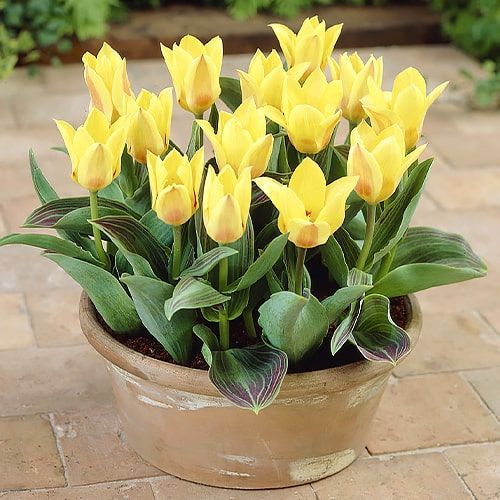
Botanical Tulips
Botanical Tulips
Last Reviews
Botanical Tulips: A Guide to Growing and Caring for These Beautiful Spring Flowers
Botanical tulips, also known as species tulips, are a group of tulips that are native to the Mediterranean and Central Asia. They are smaller in size and more delicate in appearance than their hybrid cousins, and they are often grown for their early spring bloom and natural-looking flowers. Heres a guide to growing and caring for these beautiful spring flowers:
- Choosing the right location: Botanical tulips prefer a sunny or partially shaded location with well-draining soil. They are also suitable for rock gardens, raised beds, and containers.
- Planting: Botanical tulips are usually planted in the fall, about 4-6 inches deep and 3-4 inches apart. They can also be planted in the spring, but they may not bloom as well in their first year.
- Watering: Botanical tulips need regular watering during their active growth period, but they should be kept drier during their dormant period in the summer.
- Fertilizing: Botanical tulips do not require heavy fertilization, but you can apply a balanced fertilizer in the fall when planting or in the spring before they start to grow.
- Mulching: Mulching can help conserve soil moisture and suppress weed growth. Use a layer of organic mulch, such as shredded leaves or straw, but make sure not to cover the tulip bulbs.
- Deadheading: Remove the spent blooms as soon as they start to fade. This will help divert energy back into the bulb and encourage more blooms the following year.
- Dividing: Botanical tulips can be left undisturbed for several years, but if they become overcrowded, they can be divided in the fall after the foliage has died back. Dig up the bulbs, separate them, and replant them.
Some popular varieties of botanical tulips include Tulipa clusiana, Tulipa kaufmanniana, and Tulipa humilis. These tulips are generally low-maintenance and can provide a beautiful display of color in the early spring garden.
Introduction

Botanical tulips are more delicate and smaller than hybridized tulips, which are commonly found in gardens. They bloom in early spring and come in a variety of colors, making them a popular choice for gardeners wishing to add color after a long winter. Botanical tulips can be purchased through our website or at your local nursery.
What are Botanical Tulips?
Botanical tulips are a tulip species unique to Central Asias highlands. They are smaller and more delicate than hybridized tulips, and they come in more hues, including pink, purple, yellow, and red. Botanical tulips are regarded for their beautiful, detailed blossoms and delicate foliage, as opposed to hybridized tulips, which are frequently bred for their enormous, spectacular blooms.
How to Grow Botanical Tulips
Botanical tulips are a popular choice for gardeners of all skill levels because they are quite straightforward to grow. Follow these steps to grow botanical tulips:
1. Select a sunny spot with well-draining soil. Botanical tulips prefer full sun and well-draining soil to keep the bulbs from decaying.
2. In the fall, plant the bulbs. Botanical tulips should be planted before the first frost in the fall. Plant the bulbs around 4-6 inches deep, pointed end up.
3. After planting, water the bulbs. After planting, water the bulbs thoroughly to help settle the soil and encourage root growth.
4. Keep the soil damp but not wet. Botanical tulips love damp but not saturated soil, so water them regularly but not excessively.
5. In the spring, fertilize the bulbs. When the tulips begin to blossom, treat them with a balanced fertilizer to promote healthy development and brilliant blooms.
Caring for Botanical Tulips
Once your botanical tulips are growing, its important to take care of them to ensure that they stay healthy and bloom each year. Here are some tips for caring for botanical tulips:
1. Water the bulbs regularly. Botanical tulips need regular watering, especially during dry spells.
2. Deadhead the flowers. Once the flowers start to fade, deadhead them to encourage the plant to put its energy into producing new growth instead of producing seeds.
3. Leave the foliage until it dies back naturally. After the tulips have finished blooming, leave the foliage until it dies back naturally. This will help the bulb store energy for next years growth.
4. Protect the bulbs from pests. Botanical tulips can be susceptible to pests like squirrels and deer, so protect them with netting or other deterrents if necessary.
Conclusion
Botanical tulips are a beautiful and unique addition to any garden or home interior. By following these tips for growing and caring for them, you can enjoy their delicate beauty year after year. So why wait? Buy botanical tulips today and start adding color and charm to your garden!
Frequently asked questions about Spring Flowering Botanical Tulips
When is the best time to plant botanical tulip bulbs from Holland?
How to order Dutch Botanical Tulip bulbs for your online business?
Which location do Dutch Botanical Tulips prefer?
Botanical tulips do best in a sunny to semi-shady location with well-drained soil. They are relatively undemanding and tolerate dry conditions well. A slightly raised bed or mounding in the soil can help to drain excess moisture.
Do botanical tulips flower every year?
Yes, botanical tulips are perennial and should flower again every year if cared for properly. They can even increase in beauty and size over time.
How long does it take for Botanical Tulips to flower after they have been planted?
After planting in autumn, botanical tulips need a few months of rest to develop roots. Depending on the variety and growing conditions, they may flower in spring, usually between March and May.



















